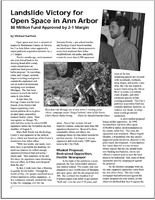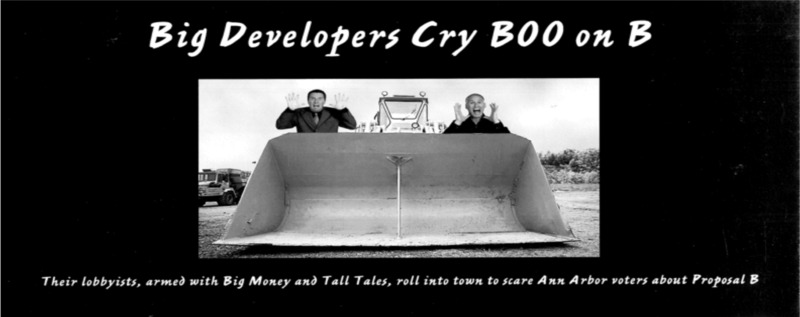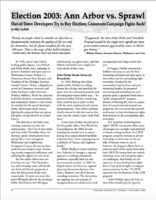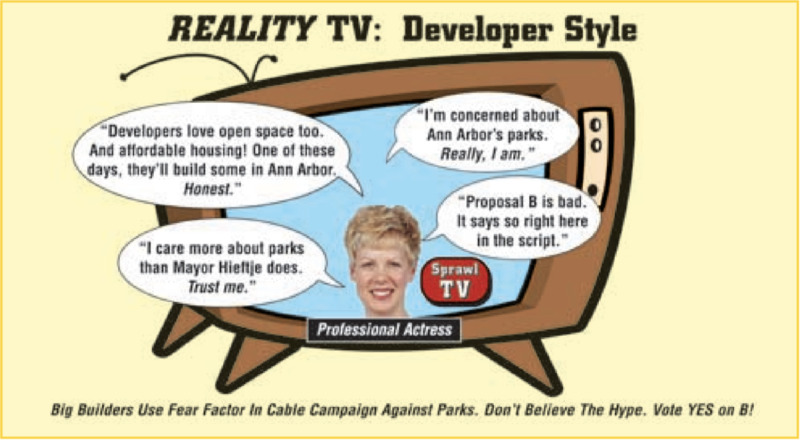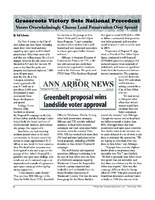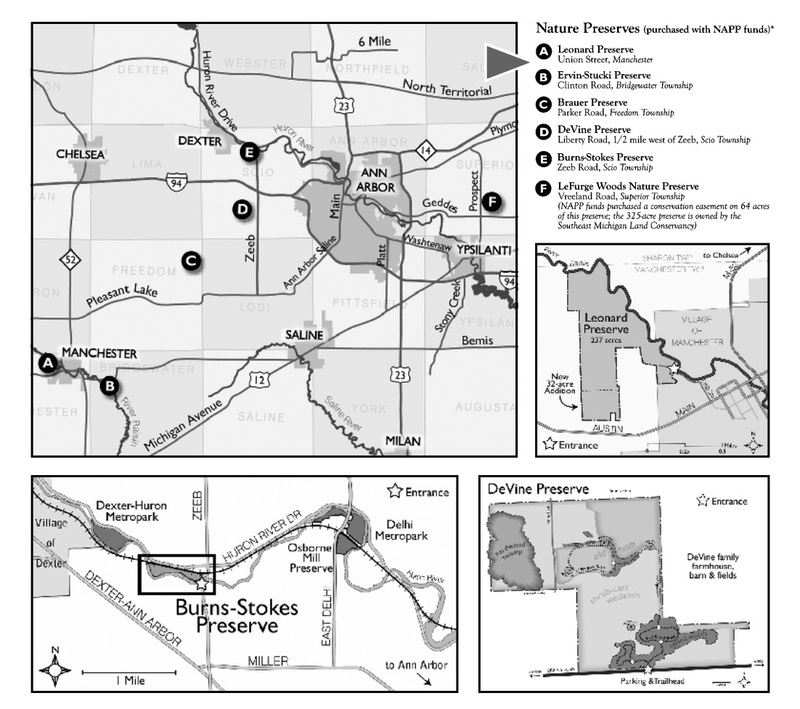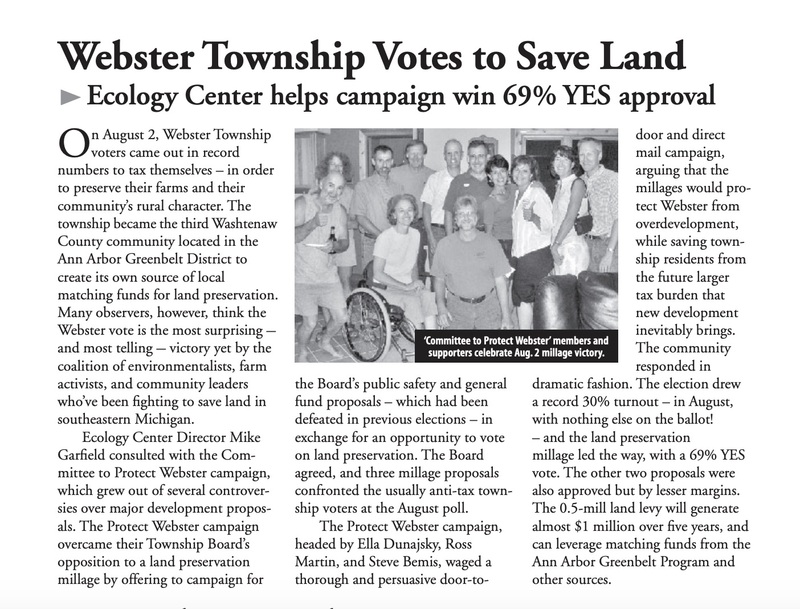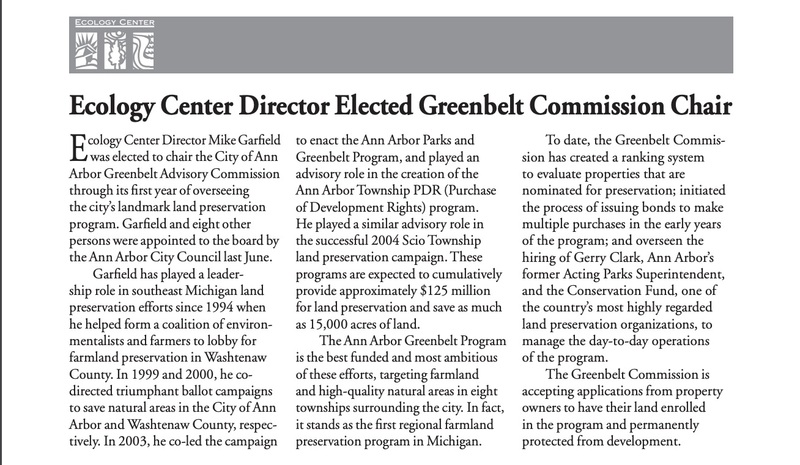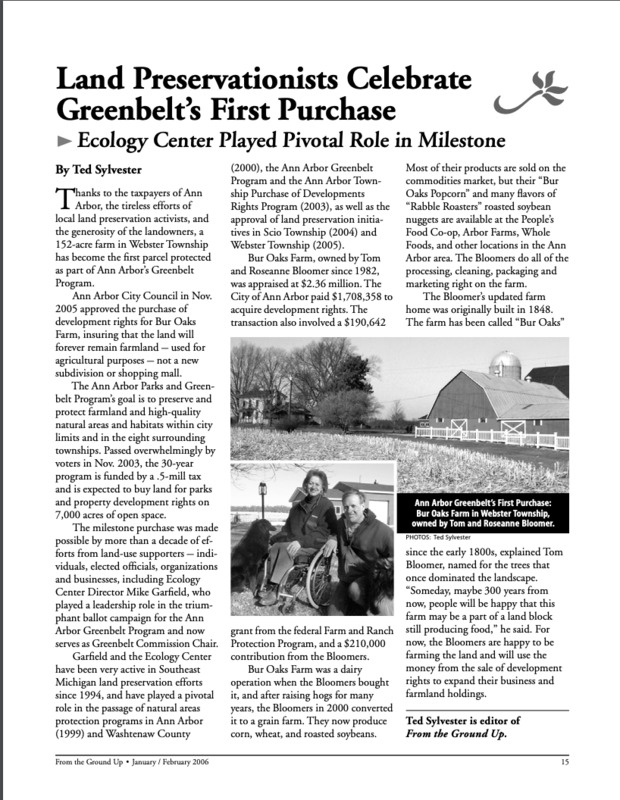Anti-Sprawl IV: The Greenbelt
Natural Areas and Farmland Protection to Stop Sprawl
The fight for the protection of natural areas through the prevention of urban sprawl was a long and strenuous battle for the Ecology Center throughout the 1990s and early 2000s. Urban sprawl happens when developers build outside of urban areas, turning natural areas and farms into subdivisions rather than building in already urban areas. In the process, sprawl destroys greenery, forests, and critical wetlands. The Ecology Center had success in protecting natural areas through Natural Features Ordinances in 1992 and two natural areas preservation proposals in 1999 and 2000, but faced serious opposition in response to farmland protection.
In 1998, the Ecology Center put Proposal 1 on the Washtenaw county ballot which aimed to raise funds to buy natural areas for preservation and buy the development rights of local farms. The purchase of development rights (PDR) program would allow the local government to buy the development rights of farms, compensating landowners and preventing the land from being developed beyond farmland, even if the landowners later sold the property. Despite wide coalition support, Proposal 1 failed due to a strong advertising campaign sponsored by the Home Builders Association (HBA), which believed PDR of farmland would limit their development opportunities. This was a hard loss, but after the successful 1999 and 2000 natural areas preservation proposals, the Ecology Center once again decided to tackle farmland preservation to stop sprawl with the Greenbelt Proposal.
The Greenbelt Proposal
Although the 1999 and 2000 proposals were successful, the Ecology Center knew that these natural areas proposals had not addressed a key issue with urban sprawl: farmland preservation. In 2003, the Ecology Center together with the Legacy Land Conservancy, Sierra Club, and the Watershed Council, once again decided to try and deal with this issue with their Greenbelt proposal. This proposal would tax Ann Arbor residents $0.5 million over 30 years in order to buy land for parks and purchase development rights for farmland in the eight townships surrounding Ann Arbor. These purchases aimed to create a belt of preserved natural area surrounding Ann Arbor that would stop urban sprawl outside of the city and therefore encourage development in already urban areas instead of rural ones. Many different entities, both competing and friendly, supported the Greenbelt. Major supporters included Mayor John Hieftje, the Ann Arbor Chamber of Commerce, and even the prominent Ann Arbor real estate company McKinley, which likely saw limitation on development as an opportunity to drive up rent prices. The Chamber of Commerce and McKinley were both in favor of the Greenbelt because it would encourage development inside of the city of Ann Arbor, therefore benefiting local businesses and local real estate.
The Greenbelt was not without opposition, however. As in 1998, the Home Builders Association was ready to fire up ads against the proposal, aiming to prevent limits on the farmland they hoped to develop. This time though, the Ecology Center was prepared and had raised money to put out ads of their own. In response to homebuilder TV ads saying that the Greenbelt would be bad for parks and schools, the Ecology Center put out ads rebutting those claims and letting Ann Arbor citizens know that those were ads put out by the HBA deliberately trying to fool voters. These counter-ads were quite successful, and many at the Ecology Center view it as a key strategy in getting the Greenbelt proposal passed.
On November 4, 2003, the Greenbelt proposal, as well as a proposal to buy land within Ann Arbor, both passed in a landslide.
"While the Greenbelt program was very controversial when it was proposed, it complimented all the other work that was going on...and when you put all these programs together and got them to start working together, we created an infrastructure and resources for this region to be able to save a lot of the most important farmland and natural areas in Washtenaw county. So the vision that we had back in the 90s has, to some extent, come to pass. And I believe there have now been over 7,500 acres of natural areas and farmland that have been saved through all of these programs."
- Interview with Michael Garfield on July 22, 2019 (40:54-41:07...41:22-41:58)
After the Greenbelt
The Greenbelt proposal passed in 2003 not only provided funding for the preservation of land in townships surrounding Ann Arbor, but it also included incentives for those townships to create funding of their own. In 2004, Scio Township passed a $0.5 million land preservation tax and Webster Township did as well in 2005.
"By the time the 2005 proposal was approved, there were now land preservation funding programs and policies in place in Washtenaw county that controlled about $100 million, enough money to save 1,000s of acres of farmland and natural areas in Washtenaw county.”
- Interview with Michael Garfield on November 1, 2019 (18:37-19:05)
Also in 2005, Mike Garfield, director of the Ecology Center and lead advocate for the Greenbelt, was elected Greenbelt Commission Chair. Under his leadership, the Greenbelt program made its first purchase, the development rights for Bur Oaks Farm, after it was approved by the Ann Arbor City Council.
The Greenbelt proposal provided 30 years of funding and is therefore still in effect today. So far, the Greenbelt alone has saved over 5,060 acres of farmland and natural areas around Ann Arbor which includes 28 miles of rivers and streams, 11 new public nature preserves, 1,476 acres of wetland, and 1,341 acres of forest.
Sources:
Chong W. Pyen, "Open-space Fans, Builders Mend Fences," Ann Arbor News, June 13, 2000.
"Natural Areas Preservation Program." Parks and Recreation Washtenaw County Michigan. https://www.washtenaw.org/939/Natural-Areas-Preservation-Program.
"Greenbelt." City of Ann Arbor Michigan. https://www.a2gov.org/greenbelt/Pages/greenbelthome.aspx

